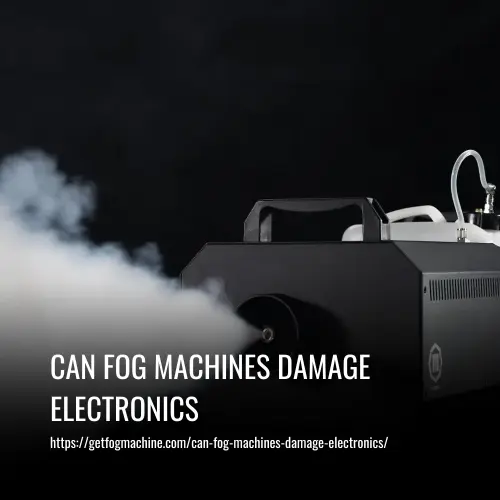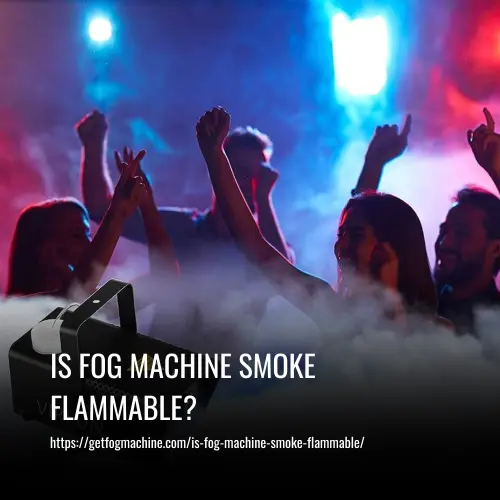Can Fog Machines Damage Electronics
This post contains affiliate links. As an Amazon Associate, we earn from qualifying purchases.
Fog machines can potentially damage electronics if not used properly. The smoke fluid used in fog machines contains propylene glycol, which can leave a residue on electronic equipment and cause damage over time.
Additionally, the particles in the fog can clog up vents and cooling systems, leading to overheating and malfunctions. It’s important to use fog machines at a safe distance from electronics and take precautions to prevent direct contact with sensitive components.
With proper care and common sense, you can enjoy using fog machines without risking damage to your electronics.

Possible Effects of Fog Machines on Electronics
Fog machines are commonly used in the entertainment industry for creating special effects, but they can pose a risk to electronic equipment. It’s important to be aware of these potential risks to prevent damage to your valuable devices:
1. Risk of Short Circuits:
Fog machines emit a dense cloud of fog, which consists of tiny water droplets. When this fog comes into contact with electrical equipment, it can cause short circuits and damage the internal components of the devices. This can result in malfunctions or even permanent damage.
2. Corrosion:
The moisture from the fog can lead to corrosion of the electrical connectors and circuitry in the electronics. Over time, this corrosion can degrade the performance and reliability of the devices. It’s important to keep electronic equipment away from fog machines to prevent this issue.
3. Overheating:
The hot fog or haze emitted by fog machines can be harmful to nearby electronic equipment, especially if placed too close or exposed for an extended period. The heat generated can cause components to overheat, leading to malfunctions or, in extreme cases, permanent damage.
4. Reduced Lifespan:
Continuous exposure to fog machines can accelerate the wear and tear on electronic equipment. The moisture from the fog can cause components to deteriorate faster, resulting in a shorter overall lifespan for the devices.
5. Malfunctioning of Sensitive Electronics:
Sensitive electronics, such as circuit boards, microprocessors, and audiovisual equipment, are particularly vulnerable to damage from fog machines. The moisture and contaminants in the fog can interfere with the delicate electronic components, causing them to malfunction or fail completely.
6. Voiding Warranty:
Using a fog machine near electronic equipment could potentially void the warranty on the devices. Most manufacturers do not cover damage caused by environmental factors like fog machines, so it’s important to exercise caution to avoid voiding your warranty.
To protect your electronic equipment from potential damage, it is recommended to keep fog machines at a safe distance and ensure proper ventilation in the studio environment. Regular maintenance and cleaning of electronic gear can also help prevent issues caused by exposure to fog machines.
How to protect your electronics from damage:
To protect your electronics from damage caused by fog machines, it is important to take the necessary precautions. Here are some tips on how to keep your valuable equipment safe:
1. Keep a Safe Distance:
When using a fog machine, ensure that it is kept at a safe distance from your electronic equipment. This reduces the chances of the fog coming into direct contact with the devices and causing damage.
2. Use a Barrier:
Consider placing a physical barrier, such as plastic sheets or covers, between the fog machine and your electronics. This acts as a protective layer, preventing moisture or fog particles from reaching the sensitive components.
3. Ensure Proper Ventilation:
Make sure the area where you are using the fog machine is well-ventilated. Good airflow helps dissipate moisture quickly and lowers the risk of corrosion or damage to your electronics.
4. Choose the Right Fog Machine:
Opt for an indoor fog machine that produces a fine particle size. Avoid smoke machines that create thick clouds or heavy smoke, as these can increase the risk of damage to electronics.
5. Select the Right Fog Fluid:
Use a fog fluid specifically designed for electronic equipment. Look for fluids labeled as “electronics-safe” or “non-corrosive.” Using the correct fog fluid minimizes the risk of damage to your electronics.
6. Monitor Particle Size:
The particle size of the fog output can impact its ability to settle on surfaces. Fine and dense fog particles have a higher chance of causing damage. Consider using fog generators with adjustable particle sizes and choose a larger size if possible.
7. Observe Safe Usage:
Follow the manufacturer’s instructions for the fog or smoke machine and use it within its recommended parameters. Overusing or misusing the machine increases the risk of damage to electronics.
8. Test Before Use:
Before using the fog machine in a production or event, test it to ensure it is working properly and does not pose a risk to electronic equipment.
9. Use Protective Covers or Enclosures:
If possible, consider placing a protective cover or enclosure around sensitive electronic equipment when using fog machines. This provides an extra level of protection against potential fog damage.
10. Regular Maintenance:
Periodically inspect and clean your electronic equipment to remove any residual fog particles or moisture. This prevents the buildup of corrosive elements and maintains the performance and reliability of your devices.
By following these tips, you can minimize the risk of damage to your electronics when using fog machines, ensuring their longevity and optimal performance.
FAQs
While fog machines have the potential to damage electronic equipment, the risk can be mitigated by following proper precautions.
The main risk is moisture or fog particles coming into contact with sensitive electronic components, leading to corrosion, short circuits, or malfunctioning.
Keep a safe distance between the fog machine and electronic equipment, use physical barriers like plastic sheets, ensure proper ventilation, choose an indoor fog machine with fine particle size, and use fog fluids specifically designed for electronics.
Opt for fluids labeled as “electronics-safe” or “non-corrosive” to minimize the risk of damage. Avoid water-based fluids as they can cause more harm.
Yes, monitor the particle size of the fog output, follow the manufacturer’s instructions, test the machine before use, use protective covers or enclosures, and regularly inspect and clean electronic equipment.
Fog machines should be used with caution around any electronic equipment. It is advisable to consult the manufacturer or an expert in the specific industry.
Some fog fluids may contain chemicals that can be harmful if inhaled. It is important to follow safety guidelines and use fog machines in well-ventilated areas.
The warm-up time can vary depending on the machine. Consult the manufacturer’s instructions for the recommended warm-up time before using the fog machine.
It is possible to use fog machines in outdoor environments, but additional precautions may be required to protect electronic equipment from environmental factors such as wind, rain, and humidity.
Yes, fog machines can potentially damage audio-visual equipment if precautions are not taken. Protect equipment, especially AV outputs, from direct exposure to fog or smoke.
Conclusion
While fog machines can potentially damage electronics if proper precautions are not taken, it is important to note that they can still be used safely in many applications. It is crucial to use the appropriate fog fluid that is specifically labeled as safe for use with electronic equipment, such as those that use propylene glycol instead of oil-based formulas.
To minimize the risk of damage, it is advisable to maintain a safe distance between the fog machine and any electronic devices. Regular maintenance and cleaning of the fog machine, including the use of distilled water for the fog fluid mixture, can also help reduce the chances of harm.
Taking such safety measures along with common sense practices can ensure that the fantastic atmospheric effects created by fog machines can be enjoyed without causing harm to electronic equipment or compromising the well-being of people.






